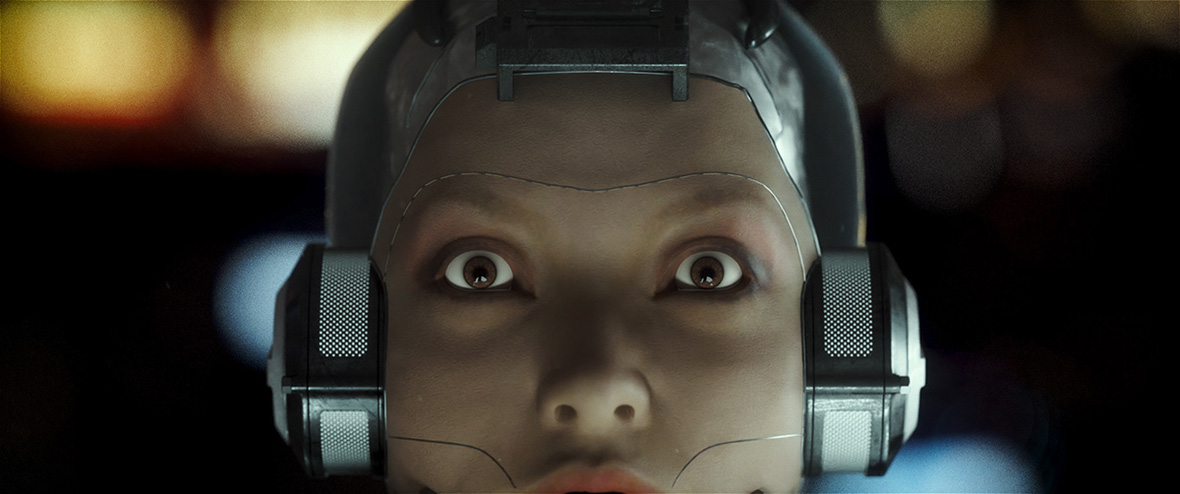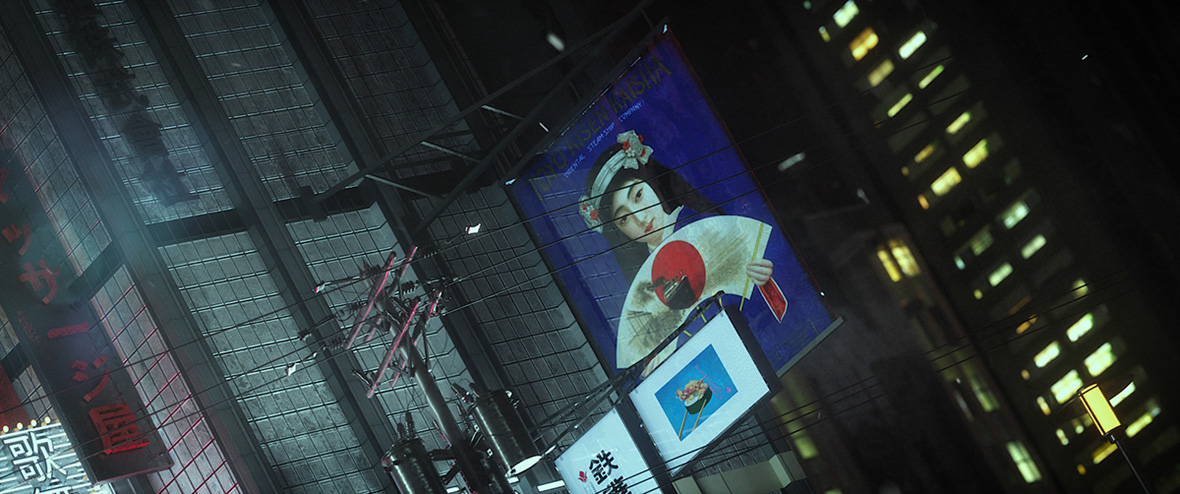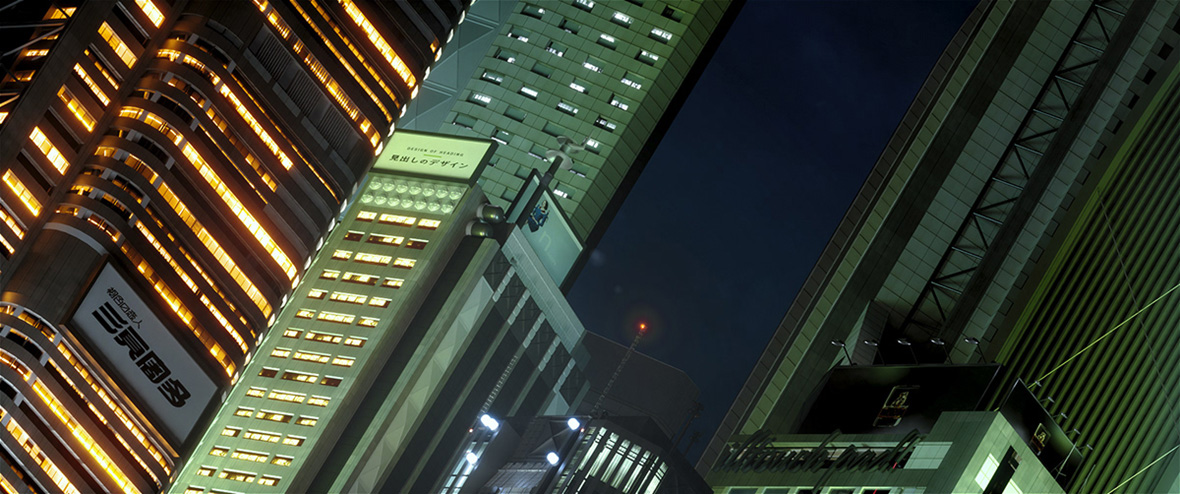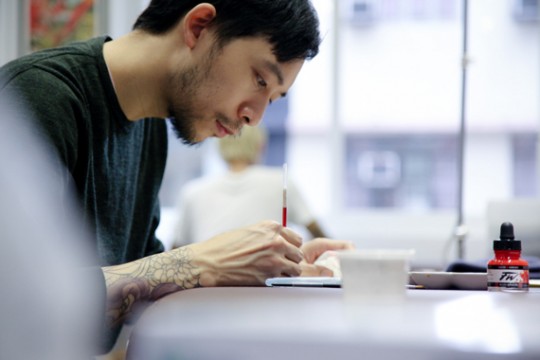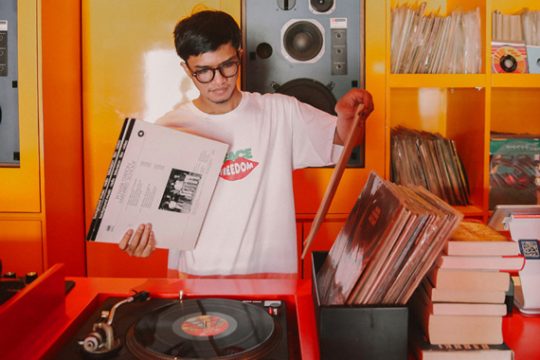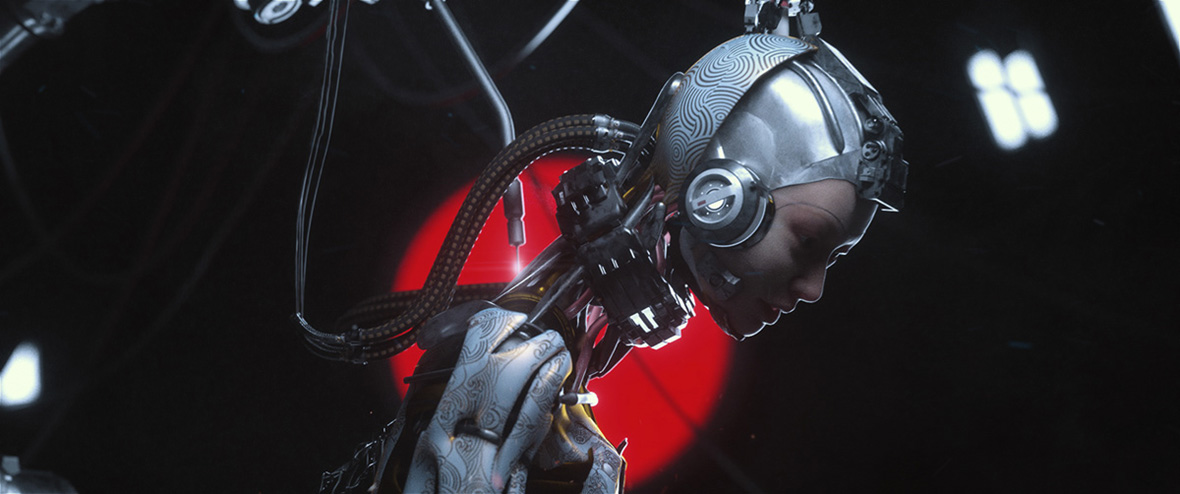
The year is 2192. In a sterile Tokyo lab, we witness the birth of a cyborg. Batteries, pistons, and sensors are meticulously assembled by other robots. Its eyes are potent cameras, and its head is covered by soft silicone, revealing the delicate features of a geisha—Kiyomi Kobayashi.
The story of a geisha frozen in time and awakened three centuries later as a cyborg spy is an ambitious project for any solo filmmaker. Yet Chinese digital artist Axl Le decided to tell it in a trilogy of short animation films under the title Kiyomi Kobayashi: Sword and Fire, The Mask, and The End of the Love.
2192 年,东京的一间无菌实验室里,一个生化机器人即将诞生。一帮机器人们围绕在她身边,正有条不紊地将电池、活塞和传感器组装在一起。这个生化机器人以强大的摄像头为眼,头部正逐渐被柔软的硅胶材质覆盖,显现出一位眉清目秀的艺伎模样,她的名字叫小林清美。
这部影片讲述了一位日本艺伎在沉睡三个世纪后被唤醒,化身为高科技打造为间谍机器人的故事。对任何电影制作人来说,单枪匹马地完成这件作品都非常需要野心。但中国数字艺术家乐毅(Axl Le)决定把这个短片做出来。他将这个故事制成了动画短片《小林清美》三部曲,其分别是《剑与火》、《面具》和《爱之终结》。
“I couldn’t produce a long-form movie at the time,” Le says. “So the solution was to make preludes and give people at least a hint of the story I had in mind.” The first two films took the form of title sequences, and the latter, of a video clip.
The narrative germinated in Le’s mind after his first visit to Kyoto. One night, on his way back to his hotel, far away from the geisha district, Le was surprised to see a lady in a pink kimono calmly making her way through the ultramodern streets. He was captivated by the contrast between this delicate character and the hypermodernity of her surroundings.
“目前,我还不能制作长篇影片,所以最开始会想做几部短片作为前奏,给观众们带来一些我脑海里的故事线索。”乐毅说。在他创作的三部曲中,前两部短片以片头的形式呈现,最后一部则更像是一段视频节选。
起初,这个故事的萌芽与乐毅第一次造访京都的经历有关。某晚乐毅正在回酒店的途中,在远离热闹的寺庙商圈之外,他意外地看到身穿粉色和服的女孩从容地穿行于现代的街道上,柔美的身影与女孩周围充满未来主义的建筑形成鲜明对比,让乐毅深深着迷。
无法观看?前往站酷
Sword and Fire is set in Kyoto in 1872, amidst the scenery of a fictional war. Le recreates the features of Japanese architecture with the same zeal that he sets the mood by manipulating light and color. There’s an underlying sense of conspiracy and mystery around the geisha, as well as hints of a tragic romance with a blood-spattered love letter alongside a soldier’s photograph.
第一部《剑与火》以 1872 年战争纷乱的京都为背景。乐毅再现了富有日本特色的建筑,通过对光影与色彩的调整,营造出影片的氛围。艺伎的身上笼罩着浓浓的不测和神秘感,一封溅满血迹的情书和旁边军人的照片,暗示着一段浪漫的悲剧故事。
无法观看?前往站酷
In The Mask, we flash forward 320 years to that harrowing Tokyo lab where Kobayashi is resurrected and transformed into an instrument of espionage. As the skin-colored silicone mask covers the animatronic structure of her head, we see her face for the first time. In this film, Le’s stylistic influences are apparent, and the opening scene looks like a hybrid of Akira and Blade Runner, with a retro-futuristic cyberpunk aesthetic.
而《面具》则把时间推进到 320 年后,在一个冰冷的东京实验室里,小林清美从沉睡中苏醒,成为一名受人摆布的间谍。软硅制成的肤色面具覆于她仿人类结构的头上,第一次展露出她的真实面貌。在这部短片中,乐毅在设计上的风格影响显而易见,开场画面如同《阿基拉》(Akira)和《银翼杀手》(Blade Runner)的混合体,呈现出带着怀旧感的未来主义赛博朋克美学。
无法观看?前往站酷
Following the suggestive title, The End of the Love has a drearier mood. Kobayashi wakes up with a bewildered look and falls defeated into her new existence. She calmly walks through the modern streets of Tokyo disguised in full geisha costume: kimono, umbrella, and straw hat. Her amazement at the cityscape shows her remaining traces of humanity.
Le’s trilogy blurs the line between fiction and reality and uses cyberpunk to allude to contemporary issues like surveillance and the control of information. “I see the future as an escape. It hasn’t happened yet, so it’s not real. But it can be used to represent reality,” he says.
到三步曲终章《爱的终结》,影片的氛围正如片名,显得尤为沉重。小林清美醒来,睁开困惑的双眼,坠落到新的世界。她身着整套艺妓服饰:和服、伞、草帽,镇定自若地漫步在现代的东京街头。周围的城市景象让她露出吃惊的表情,展现出她内心所残留的人性。
乐毅的三部短片模糊了虚构与现实之间的界线,并藉由赛博朋克来暗示一些当代社会的话题,例如监视和信息控制。“未来对我来说是一种逃离。它还没有发生,所以不是真实的。但却可以用来代表现实。”乐毅解释道。
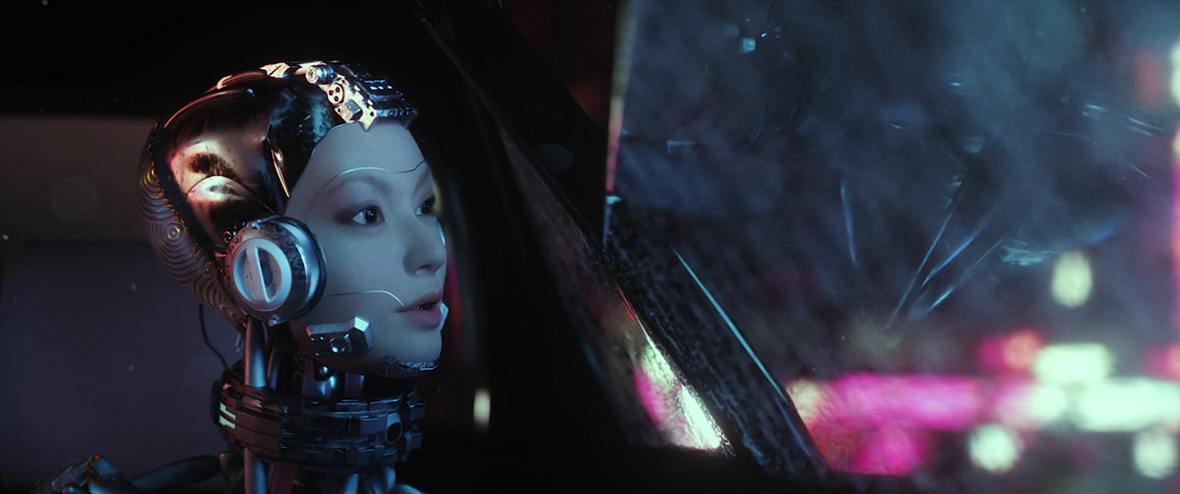
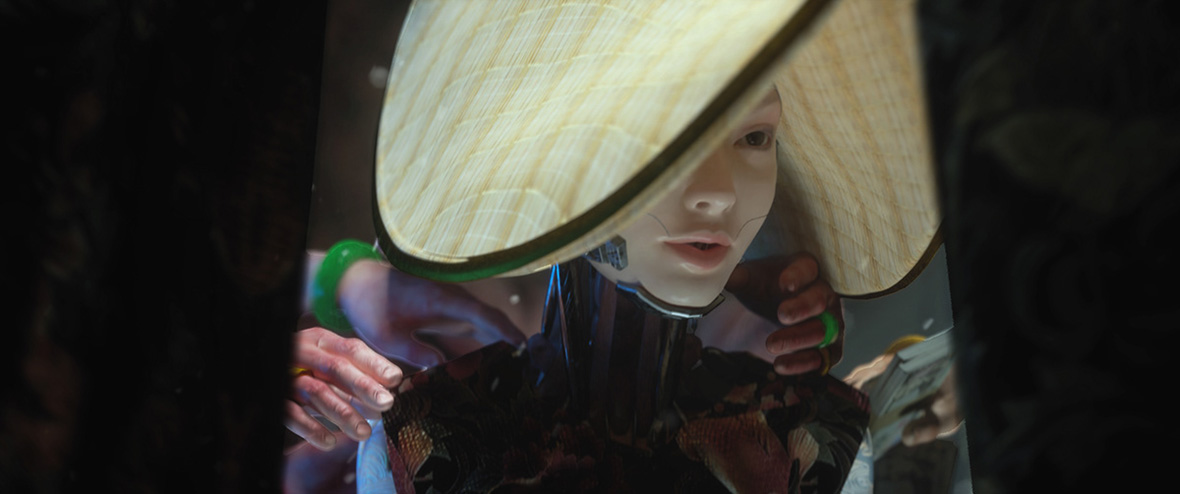
Studying architecture in college honed Le’s eye for detail and taught him how to use 3D-rendering software. A job working as an assistant to Chinese photographer Maleonn provided further aesthetic inspiration: “I learned from Maleonn how to make new stuff look old: you have to leave marks on it; it gives it a realness, like fingerprints and scratches. This is an invaluable lesson.”
The 3D-modeling process Le uses combines the digital equivalents of sculpture, painting, and photography: sculpture, because you have to start by molding something that looks like a digital clay ball; painting, because you need to set its texture, color, and opacity; and photography, because you need to set the light.
大学期间主修建筑专业的经历,养成了乐毅在创作上严谨细致的习惯,以及 3D 渲染软件的精通。而他为中国摄影师马良担任助理的经历也进一步激发了他的美学灵感:“我从马良身上学会了如何让新的事物有一种老旧的感觉:就是要在物体表面留下痕迹,譬如指纹和划痕,这样能让物体看上去更真实。这都是很宝贵的经验。”
乐毅的 3D 建模过程结合了雕塑、绘画和摄影等手段。之所以包含了雕塑,是因为整个过程必须首先从“外形”开始,这就像是在制作数字化的粘土球;而绘画则需要调整作品的质地、颜色和透明度;至于摄影,则讲究对整体光线的把控。
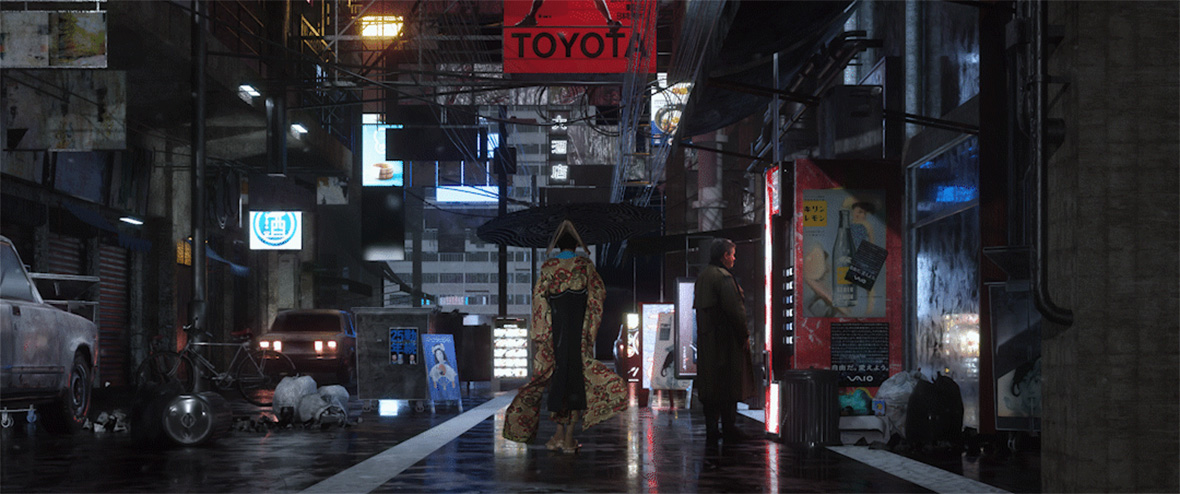
Kiyomi Kobayashi was a creative breakthrough for Le, and he hopes that it can eventually develop into a feature-length film. It’s already attracted the attention of a major art institution, the Shanghai Museum of Contemporary Art, which is currently showing the trilogy as the centerpiece of the group exhibition Do You Copy?
Do You Copy? continues at MoCA Shanghai until January 5, 2020. Tickets are available online.
Exhibition:
Do You Copy?
Dates:
Aug. 26th, 2019 ~ Jan. 5th, 2020
Address:
Museum of Contemporary Art Shanghai
231 Nanjing West Road (Inside People’s Park)
Huangpu District, Shanghai
People’s Republic of China
除了音效部分,乐毅几乎一人包揽了短片大部分的制作,他的 3D 创作与深刻的电影摄影艺术出色糅合,让人刮目相看。对乐毅来说,《小林清美》是一次创作上的突破,他也希望最终可以由此延展出一部长篇影片。这部作品也成功引起了一些大型艺术机构的关注:在上海当代艺术馆目前举办的群展“塔台呼唤”中,《小林清美》成为了主要的展览作品。
“塔台呼唤”将于上海当代艺术馆持续开放至 2020 年 1 月 5 日。前往 MoCA 微店即可购票。
展览:
塔台呼唤
展期:
2019 年 8 月 26 日 ~ 2020 年 1 月 5 日
地址:
上海当代艺术馆
上海市黄浦区
南京西路 231 号(人民公园内)
中国

